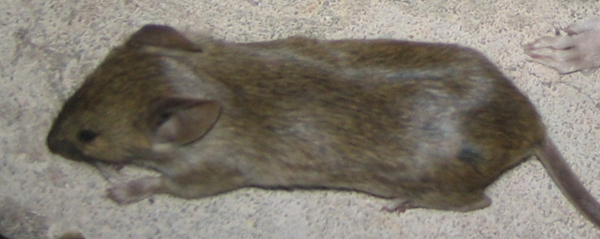- info@wildlife-removal.com
Call us for help in your town
Wildlife Removal Education
Natural Mouse Repellents
Need mouse removal in your hometown? We service over 500 USA locations! Click here to hire us in your town and check prices - updated for year 2020.
If you're looking for a mouse repellent, natural or store-bought, I must inform you that absolutely none of them work, whatsoever. Go ahead and try them if you wish, but you'll
just end up having to do the real work that it takes to solve a rat problem permanently - sealing off their entry points.
If you have mice getting into your house, and want to keep them away, there is an excellent 100% effective natural
mouse repellent -
it's called finding and
sealing shut all the entry holes in your house that the rats are using to gain entry. That's it. That's by far the most effective, and the ONLY REAL effective
way to keep away mice for good.

Mice live in a very small area. Once they've established a home, they have a 0% chance of survival if relocated somewhere else. They will die or get eaten by predators very
quickly. No mouse will ever leave its nesting area due to any repellent - because the alternative is death! It's not like the repellent will chase them away and
then they can move on to a nice new house elsewhere. It doesn't work that way with mice. They are born to know one small territory, and that's it.
I know you want an easy solution to your mouse problem, and a cheap one too. That's natural, always look for the simplest solution first! But with a mouse problem,
there is no quick and easy solution. The animals must be trapped. See my Map of Professional Rat Removal Companies for more info.
Here is a list of commonly attempted, but bogus mouse repellent products:
- Mothballs
- Ammonia
- Cat urine, coyote urine
- Peppermint oil
- High-pitch sound machines
- Flashing, bright light machines
- Toilet cakes
- Human Hair
Remember, the only way to solve a rat problem is to find out how they are getting into the building, and seal those holes shut! Then trap and remove the mice inside. Then it's often a good idea to clean the attic space.

Moth balls as mouse repellent -
Mothballs are a combination of chemicals designed to give off deadly vapors for moths and insect larvae. People assume that because mothballs are affective in this scenario that the little, white pellets will be effective against any nuisance animal. Think about a box of mothballs and your personal reaction to it. If you can sit a few feet away from an open box of mothballs and not be bothered, what makes you certain that rodents will pack up their bags and leave at the sight of the substance? It’s true that mothballs are deadly, especially if ingested; they are comprised of a known carcinogen. But rodents won’t eat the mothballs. Just like a person can sit in the same room and be unaffected, so, too, can a mouse. You would have to put an enormous amount of mothballs out to keep mice away from your property, and if you used that insane quantity, chances are you wouldn’t be able to live there either. Don’t waste your time on the mothball trial. When it comes to mice, the little creatures living in your home because it’s safe and warm, trapping and removal is the only control method. Lethal trapping and proper home maintenance will do more for your home than a truck load of mothball boxes. Read the guide How to Trap House Mice or read What Attract House Mice?.
Mice repellent peppermint oil -
Peppermint oil seems like a good idea for mouse control; peppermint oil is natural and is not offensive to the humans sharing the treated space. If you think peppermint oil is too good to be true—you’re right. Interestingly enough, in aroma therapy trials on animals, peppermint oil has more calming effects of mammals than adverse effects. For peppermint oil to bother a mouse, it would have to be applied topically to the rodent in a high enough concentration to cause skin irritation. If you place peppermint oil on a cotton ball and toss it into a mouse hole, the rodents will simply avoid it. The smell will be too strong for them to willingly approach the saturated cotton, but it’s not a smell that will raise alarm. Mice have no natural aversion to peppermint and will not associate the scent with anything dangerous. If forced to, mice will cover the offending cotton ball or push it out of the hole. Peppermint oil is the naturalist’s attempt at the same repellent theory involved when using mothballs for rodent control. Both methods are ineffective and wastes of time. If you need to remove mice from your home or business, they need to be trapped and removed. Read the guide What Are Some Humane Mouse Traps? or read Best Ways to Prevent House Mice.
Repellents for House Mice
House mice are fast breeders and each mouse can breed as much as 10 times in a year with an average of 6 pups per litter. This means that if a few mice find their way into your house, you are in for some population explosion as they can multiply rapidly in just few months. Whether young and mature, house mice will stop at nothing in their destruction of foods, paper, electric wiring, clothes, and so on. Nevertheless, they can be controlled if you get to work at it early enough. Read the guides How to Remove House Mice, How Big Can House Mice Get? or How Can You Kill A House Mouse?

Many home-sourced or natural repellents have been employed by people to get rid of house mice. These repellents are expected to chase the rodents away with odours, sound or vibration; but it is a fact that repellents hardly work for house mice. Some of them work at first and then lose their potency over time, while others do not even work at all. Popular repellent solutions include peppermint oil, mothballs, baking soda, ammonia, ultrasonic sound emitters, etc.
Pet Cats or Dogs or Kitty litter
Naturally, cats and dogs around the house are a threat to house mice. They would chase mice at sight and possibly catch and kill them. The presence of a cat especially is enough to scare house mice away.
In the alternative, you may place tubs of used kitty litter near their homes. The odoriferous tubs will produce smell of cat urine which might repel them.
Mint plants
These medicinal plants can be grown in front of windows and doors to repel any invading house mouse. Odour produced by these plants are supposedly disturbing to house mice.
Peppermint oil
This natural repellent is worth giving a try because it does not have any adverse effect on people, environment or even the house mice – unless it is in excessively large quantity. Cotton wool balls soaked in peppermint oil are thrown inside the mouse hole or in corners. In some cases, the mice will wisely just avoid it, while still going about their own way.
Baking soda
Baking soda is a commonly kitchen commodity and so is safe to be used where children and pets exist; it is also inexpensive to use and can be easily cleaned off. Just spread baking soda around the whole area where the rodents reside
Mothballs
Mothballs are commonly used in pest control due to the strong naphthalene odour that animals supposedly cannot stand. Drop moth balls into mouse holes or in corners where mice activity has been observed. In most cases though, the stubborn rodents simply change their hideout spot or ignore the moth balls altogether. Some result may be gotten if a large volume of mothballs is used, but it is a temporary solution at best. Besides, mothballs are not only going to litter your home, they are also dangerous for children, pets, and the environment.
Ammonia
The pungent odour of ammonia soaked rags or ammonia in a bowl will irritate the mice and may scare them away. Mostly though, this solution is short-lived and mice soon get used to it and start to ignore it.
Bay leaves
Bay leaves are aromatic leaves of many plants. They may also be used to repel house mice due to their strong odour. The first way to do this is to crush the leaves and sprinkle them around the whole house, and the other way is by placing whole leaves inside holes where house mice may be hiding, such as inside lockers, behind appliances, inside the pantry where foods are kept and so on.
Smoke
There are store-bought electric smoke emitters that are designed to produce harmless smoke when plugged into a power source. This smoke should scare the rodents away.
Some other people burn a woolly yarn to produce smoky incense with the aim of repelling house mice. However, the smoke is likely to take over the whole house, and that is the last thing any home owner wants or needs.
Ultrasonic sound repellent
Ultrasonic sound emitters are also widely available in stores. These produce high frequency sound waves all over the place, and although the sound may not be audible to human ears, it is detectable by the house mice. Despite being expensive however, ultrasonic sound repellents are not often effective. They are safe to be used around children and pets.
Go back to the Mice Removal page or read About House Mice.


















